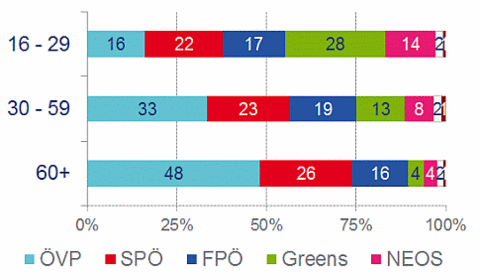
Die Seite www.foresight.at ist gerade im Aufbau. Diese Seite (sora.at) wird nicht mehr gewartet und im Frühjahr 2024 vom Netz genommen.
European Elections in Austria 2019

- Voting behaviour by age groups
On Sunday, May 26, European Elections took place in Austria for the sixth time since accession in 1995. – After this evening, the majority of voting cards (686.249 have been issued) still remains to be counted on Monday, May 27. SORA provides a prognosis of the final result here.
Analysis and motives
The ORF/SORA/ISA election day survey among 1.287 eligible voters shows which motives moved voters in this election.
Elections overshadowed by government crisis in Austria
Interior politics has been important for between 29 (ÖVP) and 83 percent (FPÖ) in this election.
Opinions on the break-up of the coalition government diverge strongly along party-political lines: Most supporters of social-democrats, Greens and liberals (NEOS) say they feel “relief”. Two third of Freedom Party supporters on the other hand are “disappointed” by the break-up of the coalition.
Among ÖVP voters, a majority of 59% is “disappointed”, 17% are relieved on the other hand.
Majority sees Austria’s EU-membership a good thing
A majority of 57% of voters see Austria’s EU-membership positive.
Only among FPÖ-supporters, 50% say that Austria should leave the EU.
Election motives
Conservatives (ÖVP) with broad mobilisation
The ÖVP succeed in mobilising broad groups of the electorate and surpass their results from the national election 2017.
7% of ÖVP-voters say they decided to vote for that party because of the current government crisis. Those are most likely ex Freedom Party supporters.
The topics most discussed in the run-up to the election among ÖVP-voters were the economy (26% discussed “very often”), migration (24%) as well as environmental protection and climate change (22%).
Social-Democrat votes for social issues and as a sign against nationalism
For 31% of SPÖ-voters, the party’s positions have been crucial for deciding fort hat party. 11% say they wanted to set a signal against right-wing parties. 8% of SPÖ-voters say they decided to vote for that party because of the current government crisis.
Most important topics for SPÖ-voters have been social politics (49% discussed „very often“), the rise of nationalist parties in Eurpe (45%) as well as environment (36%).
Freedom Party gets anti-EU votes
The Freedom Party has almost a monopoly as the party for anti-EU voters. Only the ÖVP can also mobilise some EU-sceptic votes.
Another important motive for FP-votes was interior politics: 57% of FP-voters agree very much that they also wanted to set a signal for interior politics.
Most important topics for FP-voters have been migration (70% very often discussed) and security (45%).
Green-voters worried about future of EU and climate
For 47% of Green-supporters, the party‘s positions have been the most important election motive.
As the analysis of topics discussed in the run-up to the election show, these are especially protection of the environment and climate (68%) as well al the surge of right-wing parties in Europe (54%).
NEOS appeals to pro-EU voters
Most important motives for voting for NEOS were their positions (22%), leading candidate (19%) as well as the party’s credibility (15%) and the wish to strengthen pro-EU parties in Europe (9%).
Who voted for whom?
The election day survey shows sustantial differences in voting behaviour of various socio-demographic groups.
Differences by age
The ÖVP has its best result with 48% among voters 60+. Among the young (16-29 years old), the Greens come in first with 28% in front of SPÖ (22%), FPÖ (17%), ÖVP (16%) and NEOS (14%)
Differences by occupational status and formal eductation
Among blue-collar workers, the Freedom Party came in first with 50% of the vote (ÖVP: 25%, SPÖ: 17%)
Among white-collar workers, the ÖVP reached 30%, the SPÖ 23%.
Young men without high-school degree voted above average for the Freedom Party (37% in this group).
Among voters with university degree, the Greens come in first with 30% in front of ÖVP (28%) and SPÖ (25%).
Voter transition analysis
- Download voter transition tables (German, PDF) for EUW14 - EUW19 and for NRW17 - EUW19
The SORA analysis shows voter transitions from the previous EU election in 2014. Major trends are:
- Conservatives (ÖVP) mobilise 90% of its voters from 2014 and profits most from rising turnout with 387.000 non-voters from 2014 voting for ÖVP in 2019
- 105.000 ÖVP votes come from the Freedom Party (FPÖ)
Effects of Ibizagate and government crisis
The runup to the EU-election has been marked by Ibizagate and the break-up of the coalition government. How were the parties able to mobilise their potential from the national election in October 2017?
- Conservaites (ÖVP) mobilise best and gain 69% of their voters from 2017
- Social-Democrats lose votes to Greens and Conservatives
- Freedom Party mobilises only 39% of their voters from 2017; 665.000 voters do not turn out this time
